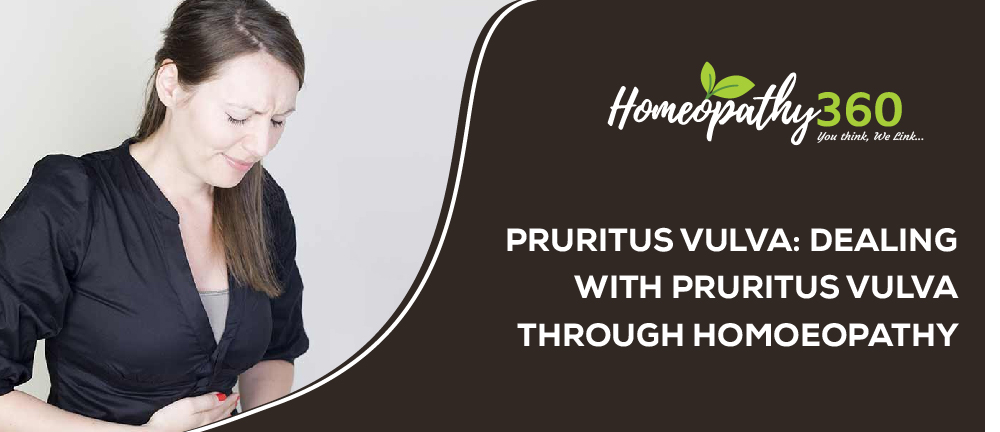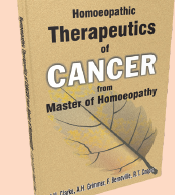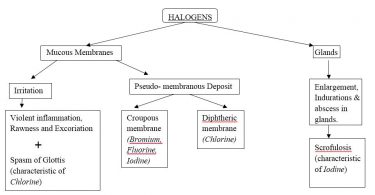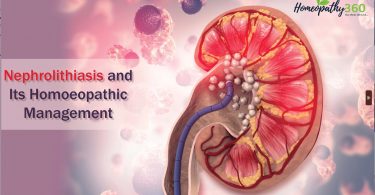
ABSTRACT
Pruritus, in general, is a distressing condition which can hamper day-to-day activities of any individual. Pruritus vulva, which is often encountered in females and due to multiple reasons is hard to deal these days. Although pruritus vulva needs much more care and precaution than it seems, at the same time, some cases require the support of appropriate medicine. In the following article, it is intended to provide knowledge about the probable reasons for this condition to arise and the homoeopathic remedies indicated along with their differentiating symptoms which can further help in dealing with cases of pruritus vulva and prevent its progression.
ABBREVIATIONS: BBCR – Boger Boenninghausen’s Characteristics and Repertory.
INTRODUCTION
Pruritus simple meaning is itching and is defined as an unpleasant sensation that provokes the urge to scratch.1 Pruritus vulva is the distressing sensation of itching with a desire to scratch in the vulva. Another condition of the female genitalia i.e Vulvar irritation may be confused with vulvar pruritus at times. But both are different since the vulvar irritation is a painful condition of the genitalia associated with burning. Prolonged or severe pruritus can eventually lead to vulvar irritation through scratching and abrasions.2 Pruritus, in general, creates a havock in the suffering individual’s life, especially if the genitalia is involved this is all the more a serious issue. There can be multiple reasons behind this which are to be kept in mind while dealing with such cases and proceeding accordingly with the requisite investigations and medications.
AETIOLOGICAL FACTORS1:
Reasons for the causation of pruritus vulva can be numerous but the most common are:
- General causes: These includes various systemic, constitutional toxic states, or disease like
- Diabetes mellitus
- Jaundice
- Uraemia
- Deficiency states of vitamin A, riboflavin, iron deficiency anaemia, pernicious anaemia
- Endocrine disorders most commonly seen in post menopausal women
- Psychogenic causes such as anxiety, stress, sexual frustration etc.
- Allergy and drug sensitivity from various chemical constituents such as soaps, cosmetics, penicillin injections, etc.
- Local causes :
- Irritating vaginal discharges due to trichomonas vaginitis and monilial vaginitis, etc.
- Disease of vulva such as tinea cruris, pediculosis, threadworms, etc.
- Chronic epithelial dystrophies such as leukoplakia, lichen sclerosis, etc.
- Carcinoma of cervix
- Idiopathic, i.e. without any specific cause.
CLINICAL FEATURES1,2 :
Presentation in the suffering individuals can be variable but mostly includes the following complaints:
- Intolerable itching of vulva
- Sometimes apthous efflorescence which encrusts the inner surface of labia and adjacent parts.
- Copper coloured appearance and abrasions.
- Vitiated watery discharge from affected surface
- Itching accompanied by sexual excitement.
INVESTIGATIONS TO BE DONE IN CASES OF PRURITUS VULVA1:
While proceeding further with the case following steps should be included:
- History which must include mode and duration of onset, intensity, relation with menses or any prolonged mental stress.
- General and local examination to exclude any dermatological diagnosis.
- Examination of discharges if any, and the blood sugar levels of the patient.
General advice regarding maintaining proper hygiene of the parts should be ensured in each and every case. Avoiding any local applications/medications for the temporary relief. Normal cotton clothing for the affected parts should be preferred to avoid any further aggravation.
SOME KNOWN HOMOEOPATHIC MEDICINES WITH THEIR CHARACTERISTIC INDICATIONS3,4,5:
- CALADIUM SEGUINUM :
Pruritus vulva especially during pregnancy and after miscarriage. Violent itching during vaginal discharge, but as the parts are sore, hot and sensitive so patient cannot scratch. Voluptuous itching of external genitalia including vulva and vagina along with onanism. Worms escape in vagina causing masturbation < by motion ; > by sweat, after sleeping in daytime.
2. COLLINSONIA CANADENSIS:
It acts predominantly on the itching of vagina caused during dysmenorrhoea. Sensation of swelling of labia and clitoris with redness of genitals. Uterine disease along with disease of rectum and bowel. Pruritus vulva with haemorrhoids especially during pregnancy. Itching < by cold, slightest mental emotion and excitement; > by heat.
3. MEZEREUM :
Eruption on the vulva probably due to the suppression of eczema or skin disease like psoriasis. Severe violent itching of the part which make the patient nervous and restless. Albuminous, corroding leucorrhoea. Vesicular eruption with thick chalk- like white crust. Itching worse at night, touch, motion, evening until midnight, cold air and > in open air.
4. BOVISTA LYCOPERDON:
She cannot bear tight clothes which cause irritation to vulva region. Intense soreness of genitalia and pubic region aggravated during menses, full moon and ameliorated by hot food. Leucorrhoea acrid, thick, tough and greenish after menses. Soreness of pubes during menses.
5. KALIUM CARBONICUM:
This remedy is well indicated in pruritus vulva especially after parturition. Erosion, itching and gnawing in genital and interior aspect of parts. Yellowish leucorrhoea with itching and sensation of burning in vulva. Violent pains in loins and pains like those of labour extending from back to uterus accompanying leucorrhoea < after coition, 3 a.m., cold weather and ameliorated in warm weather.
6. SEPIA OFFICINALIS:
Swelling and itching with eruptions on the inner labia. Yellow green leucorrhoea with itching in vagina and pudendum. Excoriation in vulva and between thighs, sometimes before menses long with soreness and redness of labia and perineum. Terrible itching of vulva causing abortion. Offensive excoriating long lasting lochia. Aggravation by washing, dampness, cold air, before thunderstorm and amelioration by exercise and warmth.
7. AMBRA GRISEA:
Pruritus vulva mainly during pregnancy, with soreness and swelling of the part; perspiration of the abdomen and thighs in the day time. Characteristic profuse bluish leucorrhoea< at night. Aggravation in morning, warm room and ameliorated in open air.
- CANTHARIS VESICATORIA:
Itching specifically during climacteric age. The skin swell in to little tumors from rubbing and scratching. Urinary difficulties accompanying pruritus. Nymphomania and constant desire to urinate with burning and painful urination. Worse from touch, micturition, coffee; ameliorated by rubbing.
- BORAX :
Pruritus of vulva and eczema. Leucorrhoea like white of an egg with sensation as if warm water is flowing. Stinging and distended feeling in clitoris. Membranous leucorrhoea. Aggravated by motion, smoking, warm weather, after menses and ameliorated by pressure, in cold weather.
- GRAPHITES :
Itching of the vulva, predominantly before menses. Leucorrhoea which is pale and excoriating with great weakness of back. Decided aversion to coition. Menses are too late and scanty with constipation. Aggravated by warmth, at night, during and after menses.
REPERTORIAL APPROACH THROUGH DIFFERENT REPERTORIES
In different repertories, one can find rubrics related to pruritus vulva under different heads which are depicted as follows:
- In MURPHY under “Female – itching, genitalia – itching, vagina, vulva”.6
- In SYNTHESIS 9.0 under “Female genitalia/sex – ITCHING – Vulva”.7
- In BBCR 8 under : 1. “Genitalia – Female organs – itching – vagina”
- “Genitalia – Female organs – itching – pudendum”
- In PHATAK directly under – “Vulva – itching”.9
- In BOERICKE under the head of “Female sexual system – Vulva, labia – Itching.”3
- In BOGER SYNOPTIC KEY directly in “Female organs – Itching.”10
- In KENT REPERTORY under- “Genitalia Female – itching – vagina”.11
CONCLUSION:
Pruritus vulva though makes a chaotic situation for most of the females these days but it can be dealt with by taking proper precautions and individualised homoeopathic treatment for the case. Various homoeopathic medicines are indicated therapeutically also in such cases according to the peculiar female symptoms and modalities but overall matching the symptom totality of the patient can provide major relief. At last according to the type of symptoms obtained after detailed case taking, different repertories can also be consulted for an appropriate idea about the probable remedies of pruritus vulva in different patients.
REFERENCES:
| 1. | Jana B, Sharma AK. Textbook of gynaecology & obstetrics. New Delhi, India: B Jain; 2000. |
| 2. | Padubidri VG, Daftary SN. Shaw’s textbook of gynecology. 16th ed. New Delhi, India: Elsevier; 2014. |
| 3. | Boericke W. New Manual of Homoeopathic Materia Medica and Repertory. 9th ed. New Delhi, India: B Jain; 2005. . |
| 4. | Clarke JH. Dictionary of practical materia medica. New Delhi, India: B Jain; 2005. |
| 5. | Lillenthal S. Homoeopathic Therapeutics. New Delhi, India: B Jain; 1998. |
| 6. | Murphy R. Homeopathic medical repertory. New Delhi, India: Leads Press; 2008. |
| 7. | Schroyens F. Synthesis 9.1: English Edition. Aberdeen, Scotland: Homeopathic Book; 2013. |
| 8. | Boger CM. Boger Boenninghausen’s Characteristics & Repertory. New Delhi, India: B Jain; 2008. |
| 9. | Phatak SR. Concise repertory of homeopathic medicines. New Delhi, India: B Jain; 2002. |
| 10. | Boger CM. Synoptic Key to Materia Medica. New Delhi, India: B Jain; 2003. |
| 11. | Kent JT. Repertory of the Homeopathic Materia Medica. New Delhi, India: B Jain; 2015. |
Dr Nanritam Chopra
- MD (PGR), Dept. of Materia Medica, Dr.M.P.K.Homoeopathic Medical College, Hospital & Research Centre, Jaipur (A constituent unit of Homoeopathy University, Jaipur, Raj. 302029) India.
Dr Itika Khatri
- MD (PGR), Dept. of Materia Medica, Dr.M.P.K.Homoeopathic Medical College, Hospital & Research Centre, Jaipur (A constituent unit of Homoeopathy University, Jaipur, Raj. 302029) India.
Dr Garima Choudhary
- MD (PGR), Dept. of Practice Of Medicine, Dr.M.P.K.Homoeopathic Medical College, Hospital & Research Centre, Jaipur (A constituent unit of Homoeopathy University, Jaipur, Raj. 302029) India.





